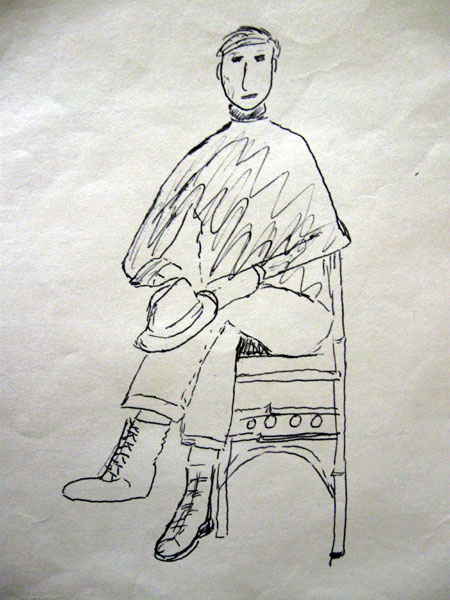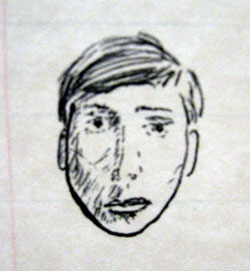This is my home-game entry for The
Real LJ Idol. I am not competing this season but invite you to read
the many fine submissions here.
Topic number 13 is just like last week, a revisitation of Throwback
Week, with several available topics. Once more, it's also Intersection
Week, meaning we're supposed to work with another contestant, each choosing
a different topic (and neither repeating topics they've already used),
with the entries linking as much or as little as you like. I paired
up with another home-game player.
I chose the theme "Moments of Devastating Beauty"

Once, I fell in love with a photograph. For hours, I'd stare into his
dark eyes, this man who had been dead for decades. And yet, time and again,
I'd turn the dog-eared pages until I found his face, as placid and perfect
as when the photograph had been taken more than a hundred years ago.
Strictly speaking, the book was my mom's, but I picked it casually off
the living room shelf to read it and soon added it to my bedroom shelf.
Later, it moved with me to a new life, boxed with books I could legitimately
call my own. Wisconsin
Death Trip
by Michael Lesy (Pantheon Books, 1973) is a fascinating compilation
of photographs and newspaper blurbs from approximately 1890-1910. The
photographs come from the collection of Charles Van Schaick, who left
behind 30,000 images that captured the turn-of-the-century life of Black
River Falls, Jackson County, Wisconsin.
In addition to competent portraits of families, individuals, and couples,
there are also eerie photos of babies in their coffins (the only portraits
their families would have) and of people who looked mentally disturbed.
The local newspaper blurbs are striking, too, because they noted things
we would never note today, such as suicides, or people being institutionalized.
But what intrigued me more than wild eyes or tragic infants was one photo
of a young man in a black turtleneck. Like the other photos in the collection,
he was unidentified: just a pale face rising above a sable sweater. He
always seemed to me to be outside of time.
He looked like he could be from any age, and I often pondered his identity
and his fate. A gentleman farmer? A college student, sitting for his first
official portrait? A time traveler, perhaps?
How long did he live after this picture was taken? Did he marry? Did
he have children? Did he pedal his Victorian time machine and head for
distant lands? Could I have known him in a past life?
Obsessed, I sketched him in cartoon style.

I did a more realistic sketch of just his face, trying to capture the
detail.

I even wrote him a poem, in the cryptic, grand style of adolescence.
The Photograph
His dead eyes held mine
with desperate isolation
and his slightly vented lips
spoke silently of longing,
his face a partly-shadow glow
rising above sable sweater
Behind him a charcoal wall
and a blurred garden window,
a bulge softened by a drape
and a substantial shadow;
all texture in
an already fascination
The formal hat held
with long, white fingers
rested rakishly on his leg
and one wrinkled boot
lifted from the floor,
brightened in afterglow
Dark hair misted his head
in sunlightened order
and sprinkled his face
with a thin shadow
From my olden self,
which lies mysterious and
deep under all history,
loneliness aerated
like an ancient book reopened,
and fervency glittered
with the blinding aura
that infiltrates children's dreams
Many hours ago
white hands touched me,
soft lips brushed my hair,
the scent of faded summer
floated around me,
and I was lost forever
in two desperate mirrors of life
Why did I find this photo so compelling? I think Lesy says it best in
his introduction:
This book is an exercise in historical actuality, but it has only
as much to do with history as the heat and spectrum of the light that
makes it visible, or the retina and optical nerve of your eye. It is as
much as exercise of history as it is an experiment in alchemy. Its primary
intention is to make you experience the pages now before you as a flexible
mirror that if turned one way can reflect the odor of the air that surrounded
me as I wrote this; if turned another, can project your anticipations
of next Monday; if turned again, can transmit the sound of breathing in
the deep winter air of a room of eighty years ago, and if turned once
again, this time backward on itself, can fuse all three images, and so
you can focus who I once was, what you might yet be, and what may have
happened, all upon a single point of your imagination, and transform them
like light focused by a lens on paper, from a lower form of energy to
a higher.
I seldom pull out the book anymore, but whenever I do, I turn to his
face. Before, in his photo, he was slightly older than me; now, much younger.
His ageless, slightly androgynous beauty is as unmarred by time as when
Charles Van Schaick released light on a glass slide a hundred years ago.
And I am still fascinated.
My partner's entry can be found here.





